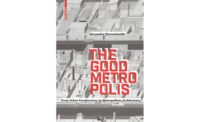Tokyo captivates. Where else could you shop beneath a bullet-train track, get lost in the world’s densest bar district, then sing karaoke in the sky? Such urban features, Tokyo’s fervent boosters insist, could exist only in Japan.
But Spanish-born architect and educator Jorge Almazán begs to differ. In his insightful, infectious study of his adopted home, Almazán pushes back against the conceit that Tokyo’s urban fabric is a fully formed reflection of a quintessential Japaneseness. Instead, the city’s urban innovations are, in Almazán’s term, “emergent,” the haphazard results of on-the-fly decisions, accidents of history, and unintended consequences that “arose as much from the bottom up through serendipity and painful necessity as [they] did through intentional design.”
For Almazán, debunking Tokyo’s only-in-Japan urban origin myth makes the metropolis matter more. After all, if Tokyo were simply the uniqueness of Japanese culture frozen in concrete, then what could the rest of the world learn from it? But if, as Almazán argues, Tokyo’s urban features cannot be explained by nihonjinron (Japaneseness), that would make them potentially replicable elsewhere.
To debunk the myth, Almazán historicizes Tokyo’s characteristic urban features, taking them one by one and unearthing how they came to be. While tourists revel in their “enthusiastic bewilderment,” Almazán and his colleagues at Keio University’s Studiolab break out their sketch pencils and sift through the city archives. The zakkyo buildings, with their stacked karaoke parlors, they learn, began their lives as mundane mid-rise offices. But when office tenants drifted away to newer, taller buildings, these structures started filling up with language schools, cafés, restaurants, comic book shops, and karaoke spots. As the public-facing businesses moved in above street level, advertising became essential. The building exteriors became a riot of neon signs, while interior stairwells and elevator banks got covered in posters and flyers. Faced with this developing new typology, the main assist from the city authorities was not getting in the way—permitting retail on high floors and embracing the garish neon aesthetic. As Studiolab’s detailed “time-lapse” sketches of Yasukuni Avenue show, in the years from 1951 to 2016, the stretch went from mostly banks and offices to mostly bars and restaurants, with several buildings (pre-pandemic, at least) entirely devoted to karaoke.
The light hand of the authorities was crucial to other iconic Tokyo typologies. In the aftermath of World War II’s devastation, black-market merchants opened stalls near train stations for customers evading the era’s rationing system. Rather than treat the merchants as criminals, the U.S. military occupiers’ Stall Clean-Up Order of 1949 treated them as eyesores and simply moved them to less prominent spaces. In these tiny alleyway stalls lie the roots of what is today Golden Gai, the vaunted nightlife district that packs over 200 drinking establishments into a footprint half the size of a FIFA regulation soccer pitch.
A similar willingness to meet reality more than halfway explains Tokyo’s famed undertrack retail strips. In the early 20th century, impoverished urbanites squatted beneath the city’s rail overpasses in makeshift hovels. Railway officials were perturbed. Living there would never be sanitary, they decided, but doing business under one could be just fine. Residential space became retail space. To this day, renting these areas, which in many Western cities are dark and empty, remains a major revenue stream for Japan’s rail system.
For Almazán, the lesson of these “emergent” Tokyo spaces isn’t that architects and urban planners elsewhere can simply drop them down in the middle of their cities. Rather, it is that design professionals should allow healthy cities to develop in the directions toward which they are trending naturally, acting more like midwives than surgeons. This light-touch approach, not any untranslatable Japaneseness, Almazán concludes, is what has allowed Tokyo “to produce lively, wildly diverse, inclusive, and innovative urban spaces. If given the chance, they could breathe new life into other cities around the world.”




Post a comment to this article
Report Abusive Comment